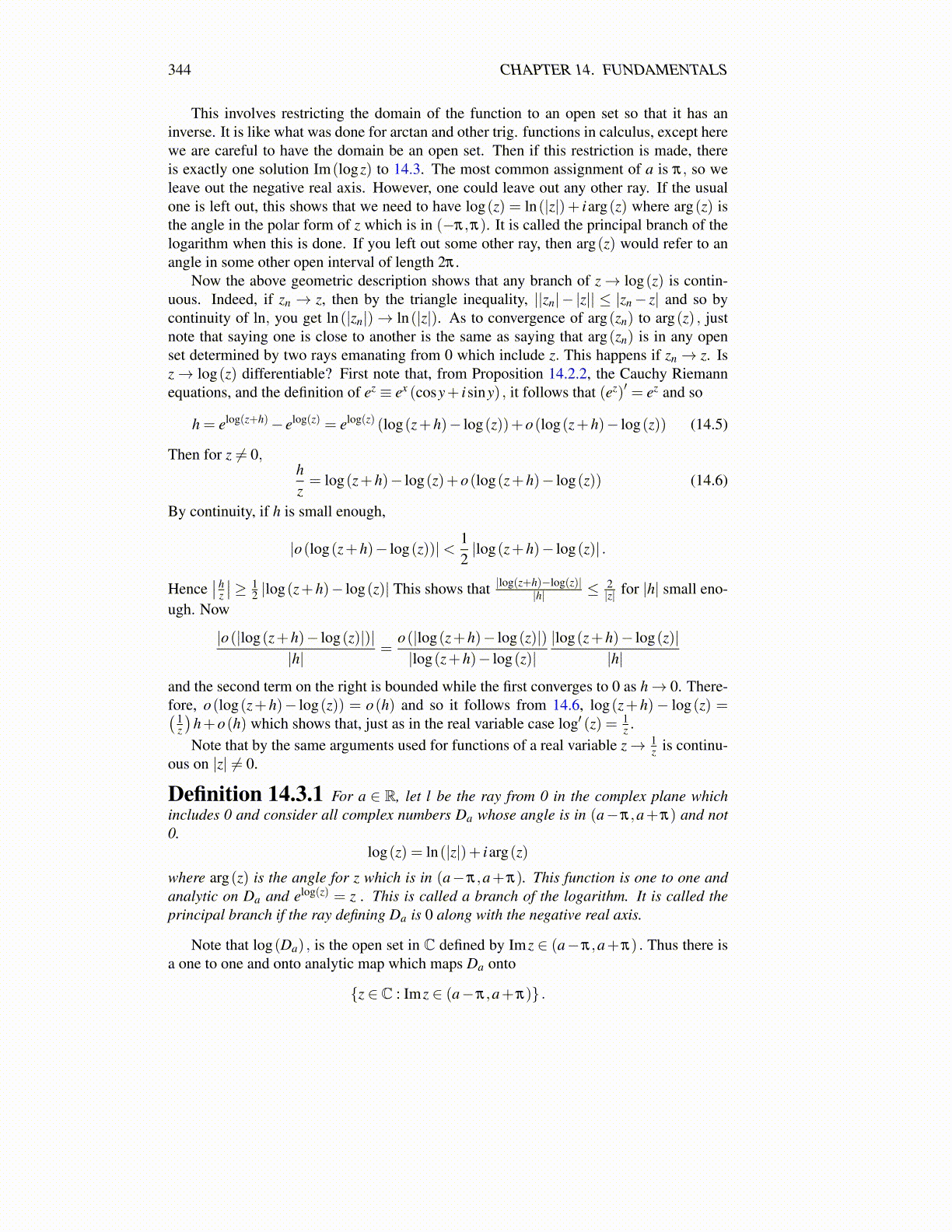
344 CHAPTER 14. FUNDAMENTALS
This involves restricting the domain of the function to an open set so that it has aninverse. It is like what was done for arctan and other trig. functions in calculus, except herewe are careful to have the domain be an open set. Then if this restriction is made, thereis exactly one solution Im(logz) to 14.3. The most common assignment of a is π, so weleave out the negative real axis. However, one could leave out any other ray. If the usualone is left out, this shows that we need to have log(z) = ln(|z|)+ iarg(z) where arg(z) isthe angle in the polar form of z which is in (−π,π). It is called the principal branch of thelogarithm when this is done. If you left out some other ray, then arg(z) would refer to anangle in some other open interval of length 2π .
Now the above geometric description shows that any branch of z→ log(z) is contin-uous. Indeed, if zn → z, then by the triangle inequality, ||zn|− |z|| ≤ |zn− z| and so bycontinuity of ln, you get ln(|zn|)→ ln(|z|). As to convergence of arg(zn) to arg(z) , justnote that saying one is close to another is the same as saying that arg(zn) is in any openset determined by two rays emanating from 0 which include z. This happens if zn→ z. Isz→ log(z) differentiable? First note that, from Proposition 14.2.2, the Cauchy Riemannequations, and the definition of ez ≡ ex (cosy+ isiny) , it follows that (ez)′ = ez and so
h = elog(z+h)− elog(z) = elog(z) (log(z+h)− log(z))+o(log(z+h)− log(z)) (14.5)
Then for z ̸= 0,hz= log(z+h)− log(z)+o(log(z+h)− log(z)) (14.6)
By continuity, if h is small enough,
|o(log(z+h)− log(z))|< 12|log(z+h)− log(z)| .
Hence∣∣ h
z
∣∣≥ 12 |log(z+h)− log(z)| This shows that |log(z+h)−log(z)|
|h| ≤ 2|z| for |h| small eno-
ugh. Now
|o(|log(z+h)− log(z)|)||h|
=o(|log(z+h)− log(z)|)|log(z+h)− log(z)|
|log(z+h)− log(z)||h|
and the second term on the right is bounded while the first converges to 0 as h→ 0. There-fore, o(log(z+h)− log(z)) = o(h) and so it follows from 14.6, log(z+h)− log(z) =( 1
z
)h+o(h) which shows that, just as in the real variable case log′ (z) = 1
z .Note that by the same arguments used for functions of a real variable z→ 1
z is continu-ous on |z| ̸= 0.
Definition 14.3.1 For a ∈ R, let l be the ray from 0 in the complex plane whichincludes 0 and consider all complex numbers Da whose angle is in (a−π,a+π) and not0.
log(z) = ln(|z|)+ iarg(z)
where arg(z) is the angle for z which is in (a−π,a+π). This function is one to one andanalytic on Da and elog(z) = z . This is called a branch of the logarithm. It is called theprincipal branch if the ray defining Da is 0 along with the negative real axis.
Note that log(Da) , is the open set in C defined by Imz ∈ (a−π,a+π) . Thus there isa one to one and onto analytic map which maps Da onto
{z ∈ C : Imz ∈ (a−π,a+π)} .